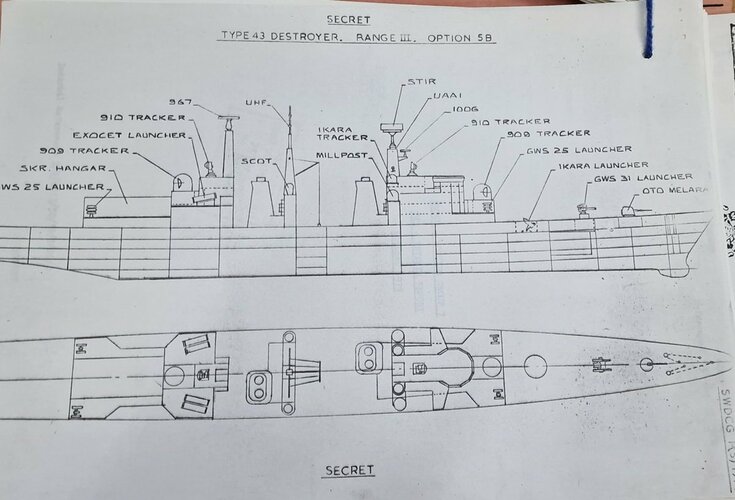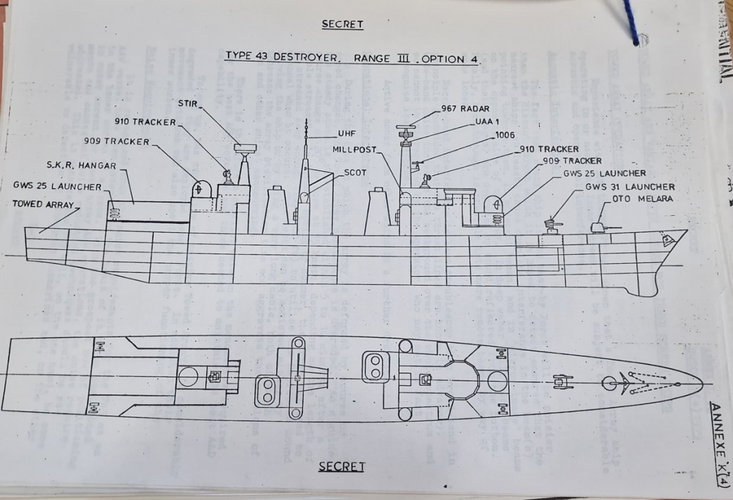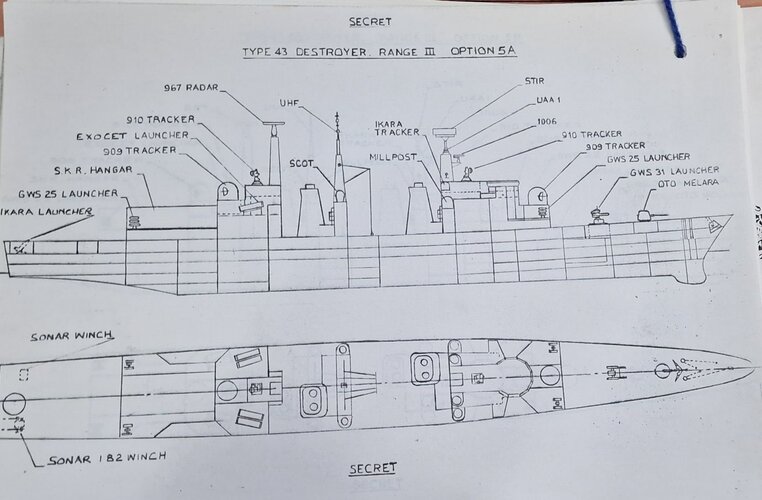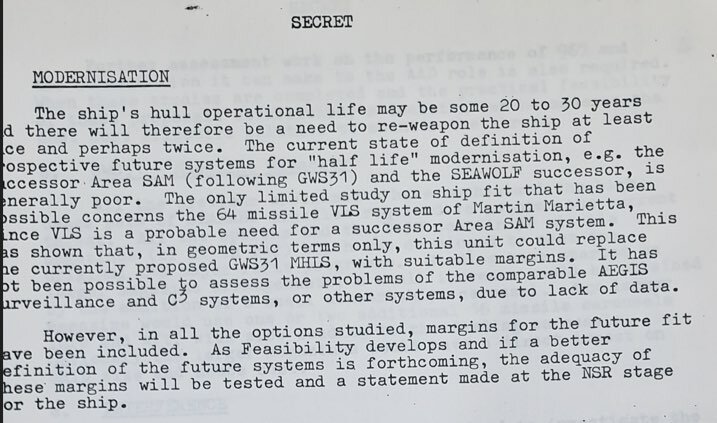You are using an out of date browser. It may not display this or other websites correctly.
You should upgrade or use an alternative browser.
You should upgrade or use an alternative browser.
British Type 43 destroyer
- Thread starter PMN1
- Start date
- Joined
- 9 October 2009
- Messages
- 21,969
- Reaction score
- 13,616
- Joined
- 6 September 2006
- Messages
- 4,833
- Reaction score
- 9,452
Some more Type 43 designs have come to light.
Sir Humphrey's X thread is well worth a read.

 threadreaderapp.com
threadreaderapp.com
Sir Humphrey's X thread is well worth a read.

Thread by @pinstripedline on Thread Reader App
@pinstripedline: This is one of the final design options for the Type 43 Destroyer. This little known cancelled project to succeed the Type 42, was far more important than generally realised, and far more capable to...…
Attachments
- Joined
- 29 September 2006
- Messages
- 1,793
- Reaction score
- 1,360
That Option 5A ticks ALL the boxes (well, save for the 76 mm main gun): Sea Wolf, Sea Dart, Exocet, Ikara, SKR… it’s like a massively improved Bristol.Some more Type 43 designs have come to light.
Sir Humphrey's X thread is well worth a read.

Thread by @pinstripedline on Thread Reader App
@pinstripedline: This is one of the final design options for the Type 43 Destroyer. This little known cancelled project to succeed the Type 42, was far more important than generally realised, and far more capable to...…threadreaderapp.com
A Tentative Fleet Plan
I really should change my personal text
- Joined
- 9 April 2018
- Messages
- 1,212
- Reaction score
- 2,833
Some more Type 43 designs have come to light.
Sir Humphrey's X thread is well worth a read.

Thread by @pinstripedline on Thread Reader App
@pinstripedline: This is one of the final design options for the Type 43 Destroyer. This little known cancelled project to succeed the Type 42, was far more important than generally realised, and far more capable to...…threadreaderapp.com
Don't forget Range III Option 5B

- Joined
- 29 September 2006
- Messages
- 1,793
- Reaction score
- 1,360
Haven’t the 910’s always been without domes?Why are the 909's in domes and the 910's not?
It's a jack of all trades, master of none. Notably, even the double-ended T43 had limited magazine capacity for air defense, with only 60 Sea Dart. (IIRC 2 x 32 magazine, each magazine 2 practice rounds)That Option 5A ticks ALL the boxes (well, save for the 76 mm main gun): Sea Wolf, Sea Dart, Exocet, Ikara, SKR… it’s like a massively improved Bristol.
And this ship is going to do AA AND ASW... Which require different positioning in a formation. Especially since it's also got a towed array.
No wonder T43 got axed, it was gold plated to hell and back, and had contradictory jobs at the end.
- Joined
- 29 September 2006
- Messages
- 1,793
- Reaction score
- 1,360
It's a jack of all trades, master of none. Notably, even the double-ended T43 had limited magazine capacity for air defense, with only 60 Sea Dart. (IIRC 2 x 32 magazine, each magazine 2 practice rounds)
And this ship is going to do AA AND ASW... Which require different positioning in a formation. Especially since it's also got a towed array.
No wonder T43 got axed, it was gold plated to hell and back, and had contradictory jobs at the end.
Good point - although it it gets ordered in enough numbers to replace all T42s - formation positioning may not be as vital, as more T43s will be available in the formation. Additionally, the Ikara’s longer reach should be able to limit ASW maneuvering to some extend.
That was very unlikely to happen with how much more the T43 would have cost.Good point - although it it gets ordered in enough numbers to replace all T42s - formation positioning may not be as vital, as more T43s will be available in the formation. Additionally, the Ikara’s longer reach should be able to limit ASW maneuvering to some extend.
- Joined
- 29 September 2006
- Messages
- 1,793
- Reaction score
- 1,360
That was very unlikely to happen with how much more the T43 would have cost.
True.
isn't the idea of having more multi-mission combatants to have more flexibility? I.e. be able to do either AAW or ASW as tasks require, not both at the same time (unless in a very stressful situation)?It's a jack of all trades, master of none. Notably, even the double-ended T43 had limited magazine capacity for air defense, with only 60 Sea Dart. (IIRC 2 x 32 magazine, each magazine 2 practice rounds)
And this ship is going to do AA AND ASW... Which require different positioning in a formation. Especially since it's also got a towed array.
No wonder T43 got axed, it was gold plated to hell and back, and had contradictory jobs at the end.
- Joined
- 6 September 2006
- Messages
- 4,833
- Reaction score
- 9,452
When you consider that Type 23 began as an ASW frigate also using the Type 43 hull (before shrinking to become the Towed Array Ship and then growing back to frigate size) you can understand why the MoD and Treasury quickly squashed these ideas.
The fact they looked ahead to possible upgrades with Mk.41 VLS is interesting. Of course had they gone with AEGIS and Standard off the bat this would have been a British Tico (with a superior close-in defence capability if it kept four Sea Wolves).
The fact they looked ahead to possible upgrades with Mk.41 VLS is interesting. Of course had they gone with AEGIS and Standard off the bat this would have been a British Tico (with a superior close-in defence capability if it kept four Sea Wolves).
Attachments
Again, jack of all trades, master of none. You can get seperate ships that do seperate things well, or you can get something that's mediocre in all things, but not amazing at anything. Unless you pay an ungodly amount of money, of course, but then you could just as well have gotten the specialized ships anyway.isn't the idea of having more multi-mission combatants to have more flexibility? I.e. be able to do either AAW or ASW as tasks require, not both at the same time (unless in a very stressful situation)?
M. A. Rozon
ACCESS: Confidential
- Joined
- 17 February 2007
- Messages
- 121
- Reaction score
- 75
Having read through all of the "Sir Humphreys" thread, I was disappointed by only one thing; the lack of dimensions other than tonnage (length, beam, draught, that sort of thing), unless I missed that, somehow. Does anyone have those bits of info or will one have to estimate off the drawings? The inquiring minds of "What If" model builders need to know!
- Joined
- 5 May 2007
- Messages
- 1,482
- Reaction score
- 2,858
They are there in the thread. I suspect that the full files he's referring to have more detail, but he's more interested in the policy angle than in the rivet-counting elements.Having read through all of the "Sir Humphreys" thread, I was disappointed by only one thing; the lack of dimensions other than tonnage (length, beam, draught, that sort of thing), unless I missed that, somehow. Does anyone have those bits of info or will one have to estimate off the drawings? The inquiring minds of "What If" model builders need to know!
Of course, but it depends if the bottleneck is cost, hull count, crew numbers, or something like machinery production or computing power, doesn't it?Again, jack of all trades, master of none. You can get seperate ships that do seperate things well, or you can get something that's mediocre in all things, but not amazing at anything. Unless you pay an ungodly amount of money, of course, but then you could just as well have gotten the specialized ships anyway.
But as one can reasonably assume that (in a high intensity conflict) any given task force requires escort against both air and submarine threats (especially with 50+ years of SSGN & sub launched anti-ship missile proliferation) the high capability specialist ships would need to be far ahead of the high capability generalist on cost grounds to be available in sufficient numbers to provide the required escorts, no? And even if they were, it would be at significantly increased cost in procurement and overhead (crewing, maintenance, etc) due to greater hull numbers.
I understand that all things are a trade off, I'm just not entirely convinced it's as cut and dry in favor of specialization and more hulls as you frame it. But of course it all depends on the specific circumstances at play in each instance, and I also don't want to get off topic.
M. A. Rozon
ACCESS: Confidential
- Joined
- 17 February 2007
- Messages
- 121
- Reaction score
- 75
Found them. Hiding right in front of my face in plain sight. Now I feel silly but it could have been much worse!They are there in the thread. I suspect that the full files he's referring to have more detail, but he's more interested in the policy angle than in the rivet-counting elements.
- Joined
- 6 September 2006
- Messages
- 4,833
- Reaction score
- 9,452
I found two items interesting.
One of the documents implied that Ikara was added as it was the only A/S weapon that could fully utilise the Type 2016 sonar's range. You could argue the opposite, that in fact no previous RN sonar allowed Ikara to be used to its full potential range.
Another document also justifies Ikara by describing it as a "close" A/S weapon. Obviously Soviet SSMs like Granit were much longer ranged than those around when Ikara was developed, and torpedo engagement distances also grew larger as Soviet sonars improved (and detection distances grew as stealth improved), so what was once a stand-off missile like Ikara was by 1980 considered to be a close-in weapon (making the STWS torpedo mountings on other frigates positively last-ditch defence!). Presumably SKR/Nimrod was looked upon at the long-range A/S 'weapon'. There were efforts like Ikara M7 with a turbojet sustainer around this period too, to give the Ikara longer legs.
To me it feels like they were cramming everything onto Type 43, perhaps reasoning that ASW ship numbers would suffer if they were built so sacrificing a double-ended Sea Dart ship to add ASW capability would salvage something. Against Regiments of Backfires and Oscars lobbing Granits about, it feels like the RN was caught between trying to defend against two formidable threats using late 1960s tech (albeit upgraded if GWS.31 went ahead). The result was bound to be big, expensive and ultimately sub optimal. Given the analysis of that time indicated a NATO task force could be wiped out within 2 days from aerial attack alone, it's not surprising the politicians thought "why bother?".
One of the documents implied that Ikara was added as it was the only A/S weapon that could fully utilise the Type 2016 sonar's range. You could argue the opposite, that in fact no previous RN sonar allowed Ikara to be used to its full potential range.
Another document also justifies Ikara by describing it as a "close" A/S weapon. Obviously Soviet SSMs like Granit were much longer ranged than those around when Ikara was developed, and torpedo engagement distances also grew larger as Soviet sonars improved (and detection distances grew as stealth improved), so what was once a stand-off missile like Ikara was by 1980 considered to be a close-in weapon (making the STWS torpedo mountings on other frigates positively last-ditch defence!). Presumably SKR/Nimrod was looked upon at the long-range A/S 'weapon'. There were efforts like Ikara M7 with a turbojet sustainer around this period too, to give the Ikara longer legs.
To me it feels like they were cramming everything onto Type 43, perhaps reasoning that ASW ship numbers would suffer if they were built so sacrificing a double-ended Sea Dart ship to add ASW capability would salvage something. Against Regiments of Backfires and Oscars lobbing Granits about, it feels like the RN was caught between trying to defend against two formidable threats using late 1960s tech (albeit upgraded if GWS.31 went ahead). The result was bound to be big, expensive and ultimately sub optimal. Given the analysis of that time indicated a NATO task force could be wiped out within 2 days from aerial attack alone, it's not surprising the politicians thought "why bother?".
- Joined
- 11 February 2007
- Messages
- 2,561
- Reaction score
- 4,360
And hull count comes in in two ways - how many of these can we get within other constraints, and how many hulls does the fleet have vs how many does it need to split required roles/functions over. The whole fleet rather than whole class view can drive things like Ikara onto platforms that might ostensibly be better without it.Of course, but it depends if the bottleneck is cost, hull count, crew numbers, or something like machinery production or computing power, doesn't it?
Last edited:
FWIW, simulation experience tells that the Soviet counterpart of Ikara, the SS-N-14b, having substantially longer range, is very useful in conjunction with a dipping-sonar-equipped helicopter. If the helicopter sonar spots a submarine, the ship can deliver a torpedo relatively fast and to sufficient distance without the need to raise the sonar and drop the torpedo by the helicopter itself, and losing the track of the target for this maneuver. Presence of a second helicopter in the area usually resolves this as well, but it's not always possible.One of the documents implied that Ikara was added as it was the only A/S weapon that could fully utilise the Type 2016 sonar's range. You could argue the opposite, that in fact no previous RN sonar allowed Ikara to be used to its full potential range.
- Joined
- 22 April 2012
- Messages
- 2,258
- Reaction score
- 2,306
To me it feels like they were cramming everything onto Type 43, perhaps reasoning that ASW ship numbers would suffer if they were built so sacrificing a double-ended Sea Dart ship to add ASW capability would salvage something. Against Regiments of Backfires and Oscars lobbing Granits about, it feels like the RN was caught between trying to defend against two formidable threats using late 1960s tech (albeit upgraded if GWS.31 went ahead). The result was bound to be big, expensive and ultimately sub optimal. Given the analysis of that time indicated a NATO task force could be wiped out within 2 days from aerial attack alone, it's not surprising the politicians thought "why bother?".
An abridged version of events:
Starting ~1976-77 there was a realisation that Fleet air defence capability needed to improve significantly. This was driven by a few things:
1. Tu-22M/Kh-22 adoption within Soviet naval aviation
2. The Soviets starting to adopt Legenda, and other OTH targeting capabilities, alongside Uspekh (e.g. Tu-95RTs and Ka-25Ts), meaning they increasingly didn’t need line of sight terrestrial targeting from vulnerable platforms
3. [A JFC observation] adoption of computer modelling for operational analysis and standardisation of threat models, e.g. the Navy got better at understanding the threat and what the right response to it was
This lead to the conclusion that the Navy needed 40 Seadart channels, they had ordered 22 by the end of 1976, and that Seadart needed to be paired with close-in 360 degree defence.
Initial analysis was made of significantly improved Type 42 variants which had the attraction of being quick and cheap to build. But that design was already tight and there were lots of new things in the pipeline that the naval staff wanted to include; Type 1030, Seadart Mk.2, new sonar, new command systems, updated habitability standards etc. that pointed to a new ship.
It was quickly realised that building a small number of 4 channel Seadart ships was the cheapest way of rapidly getting fire channels to sea and that was the basis of the initial draft of the staff requirement, that is what is reflected in the canonical Type 43 painting.
However, there was a debate about multi-role versus single-role warships but the real issue was a lack of design staff in both the navy and industry. That meant the only way forward was to adopt a design based on an existing hull, the Type 22 being chosen, which effectively forced the decision. The requirement was re-drafted and the Type 44 was born - this being reflected in the canonical Type 44 painting. The net result being that by 1980 the future building programme was shaping up to consist of a high/low mix of multirole destroyers and towed array corvettes.
In the meantime Seadart Mk.2 had been cancelled for financial reasons and a general consensus was emerging in wider Defence that the entire Navy approach to fighting WW3 was obsolete. This wasn’t entirely untrue, the CVSG/Sea Harrier combo had been conceived to kill Tu-95RTs and Ka-25Ts so breaking the kill chain. It couldn’t do anything kinetic about Legenda or Backfires, though the Navy does seem to have believed that Seadart and Seawolf could, or be upgraded so they could, kill Kh-22s. The Navy found itself in a sort of catch-22, they hadn’t been given enough money to improve air defence so the fleet looked obsolete, because it looked obsolete nobody wanted to sink more money into it. As budgets tightened post-1979 the Type 44 programme eventually died.
Last edited:
- Joined
- 6 September 2006
- Messages
- 4,833
- Reaction score
- 9,452
Ironically it was the Falklands that freed up the money to develop Sea Harrier FRS.2 with its BVR AAM capability that had more chance of tackling Backfires (I don't think that a FRS.2 Vs. Type 43 scenario could ever have arisen given that AMRAAM was simply not available at that time and Active Skyflash was also a little later than 79-80 IIRC).This wasn’t entirely untrue, the CVSG/Sea Harrier combo had been conceived to kill Tu-95RTs and Ka-25Ts so breaking the kill chain. It couldn’t do anything kinetic about Legenda or Backfires,
Legenda seems to have spurred on EW efforts from what I can tell.
Similar threads
-
RN Type 42 AAW Destroyer (Study 382) 1964 question
- Started by Thorvic
- Replies: 2
-
Advanced Technology Frigate (Great Britain, early 1990s)
- Started by Grey Havoc
- Replies: 10
-
-
-



